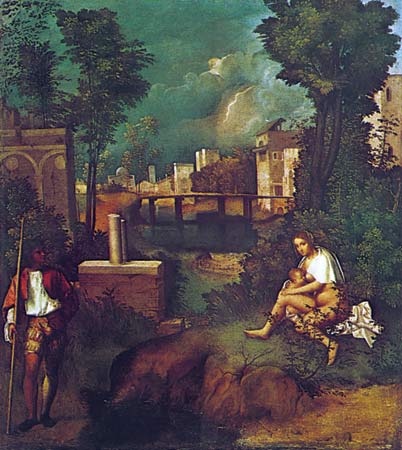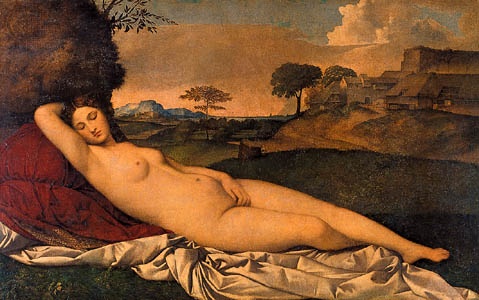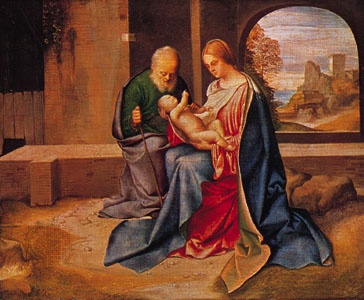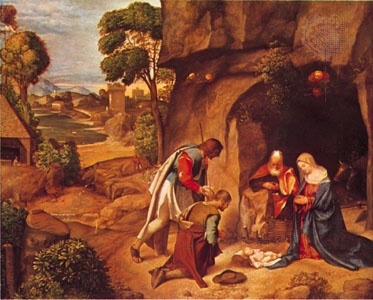Giorgione
Italian painter
Introduction
also called Giorgio da Castelfranco
born c. 1477/78, Castelfranco Veneto, Republic of Venice 【Italy】
died before Nov. 7, 1510, Venice
extremely influential Italian painter who was one of the initiators of a High Renaissance style in Venetian (Venetian school) art. His qualities of mood and mystery were epitomized in The Tempest (c. 1505), an evocative pastoral scene, which was among the first of its genre in Venetian painting.
Life
Nothing is really known about Giorgione's personal life except the legends reported by the biographer and Mannerist artist Giorgio Vasari in the two editions (1550 and 1568) of his Lives. Giorgione's name is given in two surviving documents of 1507 and 1508 as Zorzi da Castelfranco (in Venetian dialect); i.e., Giorgio of Castelfranco. The form Giorgione (or Zorzon), which is customarily used today, first appears in the 1528 inventory of the Grimani Collection. His name means “tall George,” or “big George,” implying that he was a large man. Tradition holds that he was handsome and amorous. Correspondence dated Oct. 25, 1510, between the celebrated Renaissance patron of the arts Isabella d'Este of Mantua and her agent Taddeo Albano at Venice mentions Giorgione's death as having occurred recently, probably caused by the plague that was raging in Venice at that time. Vasari's biography is the earliest. It emphasizes the artist's humble origin, his elevated mind, and his personal charm, but this characterization undoubtedly was a product of Vasari's imagination, based upon the poetic quality of Giorgione's paintings.
That the young painter went to Venice to study about 1490 under Giovanni Bellini (Bellini, Giovanni), the greatest Venetian master of the day, is undeniable. The technique, colour, and mood of Giorgione's pictures are clearly related to Bellini's late style.
Works
The commission of 1507 for a painting or paintings to be placed in the Audience Hall of the Ducal Palace at Venice was perhaps never completed, since no further notice of the work is recorded. Giorgione's principal public commission was the execution of frescoes on the exterior of the Fondaco dei Tedeschi (the German Exchange), where he painted the figures on the facade over the canal. The frescoes over the street were carried out by the young Titian, perhaps under Giorgione's direction. These works, documented in 1508, are lost, except for fragments that contain faint outlines of figures.
Aside from the works mentioned in specific documents, the notes on the art collections of Venice (Notizie d'opere del disegno), written between 1520 and 1543 by the Venetian patrician Marcantonio Michiel, contain references to pictures by Giorgione. This information occurs so shortly after the master's death that it is considered generally reliable. Of the 12 paintings and 1 drawing listed, 5 works have survived: The Tempest, The Three Philosophers, Sleeping Venus, Boy with an Arrow, and Shepherd with a Flute.
 The Tempest is a milestone in Renaissance landscape painting, with its dramatization of a storm about to break. Here is the kind of poetic interpretation of nature that the Renaissance writers Pietro Bembo (Bembo, Pietro) and Jacopo Sannazzaro (Sannazzaro, Jacopo) evoked. This feeling for nature is probably also intimately related to, though not directly derived from, the philosophical “naturalism” of the contemporary Venetian and Paduan humanists grouped around the important Renaissance philosopher Pietro Pomponazzi (Pomponazzi, Pietro). The meaning of the two people seated in the foreground of The Tempest has been the subject of numerous interpretations, none of them definitive. Michiel called them a soldier and a Gypsy. Some literary source of a romantic, Arcadian nature is generally assumed, since no Renaissance artist would include two mysterious figures devoid of meaning. The same kind of literary theme is evoked in the Pastoral Concert (c. 1510), the attribution of which is much debated.
The Tempest is a milestone in Renaissance landscape painting, with its dramatization of a storm about to break. Here is the kind of poetic interpretation of nature that the Renaissance writers Pietro Bembo (Bembo, Pietro) and Jacopo Sannazzaro (Sannazzaro, Jacopo) evoked. This feeling for nature is probably also intimately related to, though not directly derived from, the philosophical “naturalism” of the contemporary Venetian and Paduan humanists grouped around the important Renaissance philosopher Pietro Pomponazzi (Pomponazzi, Pietro). The meaning of the two people seated in the foreground of The Tempest has been the subject of numerous interpretations, none of them definitive. Michiel called them a soldier and a Gypsy. Some literary source of a romantic, Arcadian nature is generally assumed, since no Renaissance artist would include two mysterious figures devoid of meaning. The same kind of literary theme is evoked in the Pastoral Concert (c. 1510), the attribution of which is much debated. The Sleeping Venus (c. 1510) was left unfinished at Giorgione's death. Michiel stated that the task of adding the landscape background fell to Titian. The picture itself validates this statement, for the landscape, with buildings in the right distance, is repeated in other works by Titian. Giorgione's Sleeping Venus inaugurates a long series of paintings of the goddess of love in Venetian art, particularly those of Titian. None, however, achieved so fully the expression of remoteness and unself-conscious beauty as this majestic and ideally conceived figure. Judith (c. 1505), though undocumented, evokes the same concept of universal beauty; she is more goddess than avenger of her people.
The Sleeping Venus (c. 1510) was left unfinished at Giorgione's death. Michiel stated that the task of adding the landscape background fell to Titian. The picture itself validates this statement, for the landscape, with buildings in the right distance, is repeated in other works by Titian. Giorgione's Sleeping Venus inaugurates a long series of paintings of the goddess of love in Venetian art, particularly those of Titian. None, however, achieved so fully the expression of remoteness and unself-conscious beauty as this majestic and ideally conceived figure. Judith (c. 1505), though undocumented, evokes the same concept of universal beauty; she is more goddess than avenger of her people. Few religious paintings are mentioned in the early documentary sources. The panels representing the Trial of Moses and the Judgment of Solomon are generally agreed to number among the artist's first works (c. 1495–1500). Although the figures look slightly archaic, the beauty of the landscape setting, with its soft melting distances, unmistakably reveals the hand of the painter of The Tempest. Most celebrated of his religious pictures is the Castelfranco Altarpiece (c. 1504). The composition of this painting forms an equilateral triangle in conformance with the search for geometric solutions characteristic of the Renaissance mind. Thoroughly in the spirit of the master are the landscape and the dreamy mood of the figures, who seem lost in reverie. The Holy Family (c. 1500) and the Adoration of the Shepherds (shepherds, adoration of the) (1505/1510) are of equally fine quality. The latter is particularly noteworthy for its exquisite use of colour.
Few religious paintings are mentioned in the early documentary sources. The panels representing the Trial of Moses and the Judgment of Solomon are generally agreed to number among the artist's first works (c. 1495–1500). Although the figures look slightly archaic, the beauty of the landscape setting, with its soft melting distances, unmistakably reveals the hand of the painter of The Tempest. Most celebrated of his religious pictures is the Castelfranco Altarpiece (c. 1504). The composition of this painting forms an equilateral triangle in conformance with the search for geometric solutions characteristic of the Renaissance mind. Thoroughly in the spirit of the master are the landscape and the dreamy mood of the figures, who seem lost in reverie. The Holy Family (c. 1500) and the Adoration of the Shepherds (shepherds, adoration of the) (1505/1510) are of equally fine quality. The latter is particularly noteworthy for its exquisite use of colour. The Three Philosophers (c. 1510) is one of the works Michiel saw and specifically identified as being by Giorgione. He stated, however, that it was completed by the Venetian painter Sebastiano del Piombo after the master's death. The composition and colour are so fully Giorgione's that Sebastiano could only have added a few finishing touches. In addition, the dreamy melancholy of the three men—who represent youth, maturity, and old age—embodies the spirit of the master. Though the notion of three ages of man is surely implied, little agreement prevails among critics as to whether the three magi, three philosophers, or a literary source in ancient Roman legend is really intended.
The Three Philosophers (c. 1510) is one of the works Michiel saw and specifically identified as being by Giorgione. He stated, however, that it was completed by the Venetian painter Sebastiano del Piombo after the master's death. The composition and colour are so fully Giorgione's that Sebastiano could only have added a few finishing touches. In addition, the dreamy melancholy of the three men—who represent youth, maturity, and old age—embodies the spirit of the master. Though the notion of three ages of man is surely implied, little agreement prevails among critics as to whether the three magi, three philosophers, or a literary source in ancient Roman legend is really intended.The Christ Carrying the Cross is widely disputed even today. Nevertheless, Vasari in 1568 specifically stated that the painter was Titian, correcting an error that he had committed in the edition of 1550 in attributing the picture to Giorgione. The canvas, much restored and repainted, possesses no more than archaeological interest. Other questioned paintings that seem to a number of contemporary critics to be the works of Giorgione rather than Titian are The Adulteress Brought Before Christ (c. 1500), the Madonna and Child with SS. Roch and Anthony of Padua (c. 1505), and the Madonna and Child in a Landscape (c. 1504).
Influence and significance
In portraiture Giorgione made a most profound and far-reaching impression. Venetian painters such as Titian, Palma Vecchio, and Lorenzo Lotto so closely imitated him in the early 16th century that it is at times virtually impossible to distinguish between them. Nevertheless, the portrait of a Youth (c. 1504) is universally considered to be by Giorgione. The indescribably subtle expression of serenity and the immobile features, added to the chiseled effect of the silhouette and modeling, combine to make the Youth an unforgettable expression of Renaissance man. The same sort of exquisite refinement and sensibility characterizes the disputed portrait supposedly of the poet Antonio Broccardo (c. 1506). Accepted by all critics is the portrait of the so-called Laura, on the back of which is an inscription giving the date as June 1, 1506, and Zorzi of Castelfranco as the painter.
Giorgione's Self-Portrait as David (c. 1510), recorded in an engraving of 1650 by the well-known German engraver Wenzel Hollar (Hollar, Wenceslaus), can safely be considered a much-damaged original that has been drastically cut down in size. The artist gave his own portrait more dramatic force by the frown upon his face and by turning the body inward at an angle to the parapet. Titian adopted the same arrangement in his portrait of a gentleman in blue (c. 1512), where the initials TV (Tiziano Vecellio) establish him as the painter rather than Giorgione, as was formerly believed.
Despite considerable recent research, the short-lived master from Castelfranco still remains one of the most enigmatic of Renaissance painters. Yet the quality and charm of his paintings have made him as highly esteemed today as he was in his own time—a Venetian master of poetic mood created through idealized form, colour, and light.
Additional Reading
George Martin Richter, Giorgio da Castelfranco, Called Giorgione (1937), is a catalogue raisonné with complete bibliography up to 1936. Terisio Pignatti, Giorgione (1971; originally published in Italian, 1969), contains documentation and bibliography reproduced from Richter but brought up to date. Ludwig Baldass and Günther Heinz, Giorgione (1965; originally published in German, 1964), is also useful in providing more modern scholarship. Salvatore Settis, Giorgione's Tempest: Interpreting the Hidden Subject (1990; originally published in Italian, 1978), analyzes a single painting.
- Abel, Sir Frederick Augustus
- Abelson, Philip Hauge
- Abel Tasman National Park
- Abel Tendekayi Muzorewa
- Abel, Theodora Mead
- Abemama Atoll
- Abe Masahiro
- Abenaki
- Abengourou
- Abenteuerroman
- Abeokuta
- Abercrombie & Fitch Co.
- Abercrombie, James
- Abercrombie, Lascelles
- Abercrombie, Sir Patrick
- Abercromby, Sir Ralph
- Aberdare
- Aberdare Range
- Aberdeen
- Aberdeen, George Hamilton-Gordon, 4th Earl of, Viscount Gordon Of Aberdeen, Viscount Of Formartine, Lord Haddo, Methlick, Tarves, And Kellie
- Aberdeenshire
- Abe Reles
- Abergavenny
- Aberhart, William
- Abernathy, Ralph David